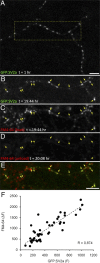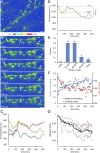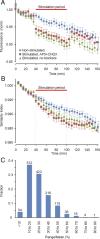Use dependence of presynaptic tenacity
- PMID: 22090503
- PMCID: PMC6633291
- DOI: 10.1523/JNEUROSCI.3384-11.2011
Use dependence of presynaptic tenacity
Abstract
Recent studies indicate that synaptic vesicles (SVs) are continuously interchanged among nearby synapses at very significant rates. These dynamics and the lack of obvious barriers confining synaptic vesicles to specific synapses would seem to challenge the ability of synapses to maintain a constant amount of synaptic vesicles over prolonged time scales. Moreover, the extensive mobilization of synaptic vesicles associated with presynaptic activity might be expected to intensify this challenge. Here we examined the ability of individual presynaptic boutons of rat hippocampal neurons to maintain their synaptic vesicle content, and the degree to which this ability is affected by continuous activity. We found that the synaptic vesicle content of individual boutons belonging to the same axons gradually changed over several hours, and that these changes occurred independently of activity. Intermittent stimulation for 1 h accelerated rates of vesicle pool size change. Interestingly, however, following stimulation cessation, vesicle pool size change rates gradually converged with basal change rates. Over similar time scales, active zones (AZs) exhibited substantial remodeling; yet, unlike synaptic vesicles, AZ remodeling was not affected by the stimulation paradigms used here. These findings indicate that enhanced activity levels can increase synaptic vesicle redistribution among nearby synapses, but also highlight the presence of forces that act to restore particular set points in terms of SV contents, and support a role for active zones in preserving such set points. These findings also indicate, however, that neither AZ size nor SV content set points are particularly stable, questioning the long-term tenacity of presynaptic specializations.
Figures







Similar articles
-
Exchange and redistribution dynamics of the cytoskeleton of the active zone molecule bassoon.J Neurosci. 2009 Jan 14;29(2):351-8. doi: 10.1523/JNEUROSCI.4777-08.2009. J Neurosci. 2009. PMID: 19144835 Free PMC article.
-
Synapsin selectively controls the mobility of resting pool vesicles at hippocampal terminals.J Neurosci. 2012 Mar 21;32(12):3969-80. doi: 10.1523/JNEUROSCI.5058-11.2012. J Neurosci. 2012. PMID: 22442064 Free PMC article.
-
Synaptic vesicle retrieval time is a cell-wide rather than individual-synapse property.Nat Neurosci. 2011 May 29;14(7):824-6. doi: 10.1038/nn.2828. Nat Neurosci. 2011. PMID: 21623361 Free PMC article.
-
GABA vesicles at synapses: are there 2 distinct pools?Neuroscientist. 2009 Jun;15(3):218-24. doi: 10.1177/1073858408326431. Neuroscientist. 2009. PMID: 19436074 Free PMC article. Review.
-
Synaptic vesicle pools and dynamics.Cold Spring Harb Perspect Biol. 2012 Aug 1;4(8):a013680. doi: 10.1101/cshperspect.a013680. Cold Spring Harb Perspect Biol. 2012. PMID: 22745285 Free PMC article. Review.
Cited by
-
Synaptic vesicle recycling: steps and principles.EMBO J. 2014 Apr 16;33(8):788-822. doi: 10.1002/embj.201386357. Epub 2014 Mar 3. EMBO J. 2014. PMID: 24596248 Free PMC article. Review.
-
Formation of Golgi-derived active zone precursor vesicles.J Neurosci. 2012 Aug 8;32(32):11095-108. doi: 10.1523/JNEUROSCI.0195-12.2012. J Neurosci. 2012. PMID: 22875941 Free PMC article.
-
Long-term relationships between cholinergic tone, synchronous bursting and synaptic remodeling.PLoS One. 2012;7(7):e40980. doi: 10.1371/journal.pone.0040980. Epub 2012 Jul 23. PLoS One. 2012. PMID: 22911726 Free PMC article.
-
Relative Contributions of Specific Activity Histories and Spontaneous Processes to Size Remodeling of Glutamatergic Synapses.PLoS Biol. 2016 Oct 24;14(10):e1002572. doi: 10.1371/journal.pbio.1002572. eCollection 2016 Oct. PLoS Biol. 2016. PMID: 27776122 Free PMC article.
-
Linking spontaneous and stimulated spine dynamics.Commun Biol. 2023 Sep 11;6(1):930. doi: 10.1038/s42003-023-05303-1. Commun Biol. 2023. PMID: 37696988 Free PMC article.
References
-
- Ahmari SE, Buchanan J, Smith SJ. Assembly of presynaptic active zones from cytoplasmic transport packets. Nat Neurosci. 2000;3:445–451. - PubMed
-
- Bajjalieh SM, Peterson K, Shinghal R, Scheller RH. SV2, a brain synaptic vesicle protein homologous to bacterial transporters. Science. 1992;257:1271–1273. - PubMed
-
- Brigidi GS, Bamji SX. Cadherin-catenin adhesion complexes at the synapse. Curr Opin Neurobiol. 2011;21:208–214. - PubMed
Publication types
MeSH terms
Substances
Grants and funding
LinkOut - more resources
Full Text Sources
